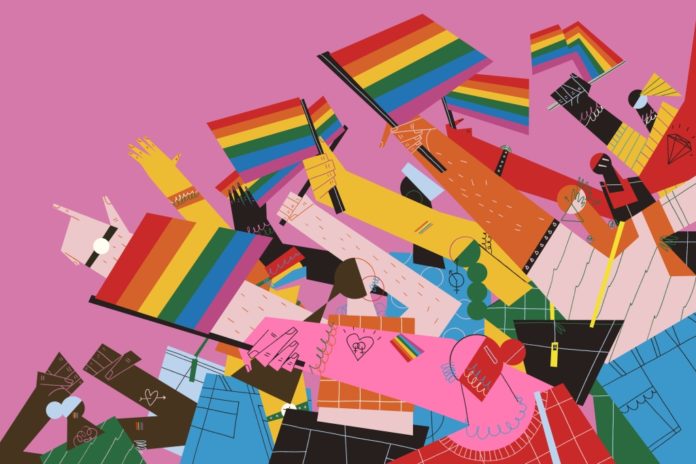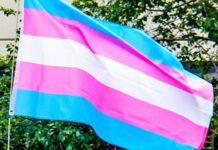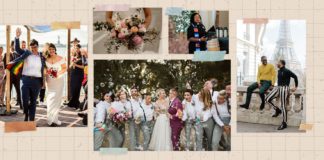
There may be no industry in the world that touches more of the world’s diverse population than fashion.
And that means there may be no industry in the world better equipped — or, at the very least, more reasonably expected — to use its presence for a purpose. When it comes to issues unrelated to the latest trends or dropping just the right names, fashion can seem split on whether to speak or stay mum. But when it comes to social impact and equality, consumers are prioritizing brands that prioritize more than their bottom lines.
While fashion’s conversations have been largely focused on racial diversity of late, where the work needed has been made more evident in recent years, there is underway in the U.S. what designer Alexis Bittar would consider “a huge swing right,” meaning a move to more conservative ideals. And those movements are increasingly threatening women’s and LGBTQ rights, among other things.
Florida has made waves in recent months thanks to its Parental Rights in Education (more colloquially known as the “Don’t Say Gay Bill”) which takes effect on July 1 and would succeed in “prohibiting a school district from encouraging classroom discussion about sexual orientation or gender identity in primary grade levels or in a specified manner,” according to language in the bill.
In Texas, the state’s Department of Family and Protective Services opened an investigation into a family who helped their transgender child undergo gender-affirming treatment. More broadly, the state wants medical treatments for transgender adolescents to be classified as “child abuse.”
Across the U.S., according to a legislative tracker compiled by Freedom for All Americans, a campaign fighting for LGBTQ nondiscrimination protections nationwide, there are more than 200 bills up for consideration in the 2022 legislative session related to LGBTQ discrimination. Some, like Ohio’s Save Adolescents from Experimentation Act, specify that, “no physician or other medical health care professional shall provide gender transition procedures to any person under 18 years of age.” Others, like Louisiana’s Provides for the Fairness in Women’s Sports Act, “require that schools designate intercollegiate and interscholastic athletic teams according to the biological sex of the team members.”
If you ask William Eskridge, Jr., currently the John A. Garver Professor of Jurisprudence at Yale Law School, who was the lawyer representing a gay couple in the first lawsuit fighting for same-sex marriage, and who has spent 30 years fighting for marriage equality, what’s happening now is “hydraulic.”
“Prejudice and stereotyping don’t go away simply because LGBTQ people have rights now as parents, as spouses, as holders of jobs, as beneficiaries of health insurance. Those are, I think, fairly well established now. But it doesn’t mean that anxiety about gender and sexual minorities has gone away, and such prejudice and stereotyping is hydraulic. If it’s squished down in one area, it might reemerge in another area and we’re seeing that,” he said. “So transgender persons can now marry the person of their choice, if they want. They now can have jobs, they’re not supposed to be discriminated against. But both prejudiced people and their political demagogues, like Gov. [Ron] DeSantis [R-Fla.], have an incentive to find new places to express their animus against people they don’t like, are jealous of, feel competitive with or something.”
Admittedly, while Eskridge doesn’t think Obergefell v. Hodges — the 2015 case that ruled the right to marry is guaranteed to same-sex couples everywhere in the country — will be overturned, he does consider it to be under threat.
“There’s always a threat to marriage equality as long as the Supreme Court has dedicated ideologues on it… I think there are six of nine [justices] who do think Obergefell was wrongly decided and are not going to be eager to expand upon Obergefell. I don’t think there’s a majority to overrule it but I think the willingness to actually enforce Obergefell is very shaky at this point,” he said. “I don’t think the Supreme Court is going to overrule Obergefell but I think that Obergefell is in peril and I think Bostock [v. Clayton County, the Supreme Court case that ruled in 2020 to protect employees from discrimination for being gay or transgender] is in peril, of being chipped away at by religious allowances.”
What’s more — and may be of particular note for fashion — is a case currently before the Supreme Court, 303 Creative v. Elenis. Lorie Smith owns design firm 303 Creative and because she claims to oppose same-sex marriage on religious grounds, she does not want to design websites for same-sex marriages and wants to note this on her own business website.
According to Eskridge, the way this case goes for a website designer could also hold new meaning for designers in fashion. The question before the court is whether Smith should be able to refuse to deal with people whose beliefs don’t align with hers. Similar cases in the past have gone in different directions, some siding with the business owner’s right to discriminate, others ruling they can’t.
If the Supreme Court were to decide in Smith’s favor, agreeing that she does not have to create websites for same-sex weddings and thus, same-sex couples, a fashion designer might similarly be able to argue they didn’t want to create suits or wedding gowns for same-sex weddings.
“There are some anti-discrimination laws, in Michigan for example, that do protect against discrimination in services and sales based upon weight and height and some other characteristics,” Eskridge said. “But it’s an interesting issue that’s being raised in the law that I think has sort of a broader interest.”
All of this, Bittar said, is cause for concern.
“Even when Trump was elected, I was concerned. And how he pandered to the religious right, I worried really because I’m a gay parent and I guess it’s just super primal, like do I have to be concerned? I think being a gay man and having grown up through the AIDS crisis and been super exposed to everything…to get to a place where you can marry and have children was a huge deal and changed the landscape on how I feel about myself and what my life can look like. I was cut out by my family for being gay so I definitely dealt with a lot of issues around being accepted and societal pressures,” he said.
But when it comes to fashion’s role to play in all of this, it’s hard to say, he admitted. “Being on the left as a designer, it’s like what power do you have? And I think the first piece is we’re not going to get anywhere by yelling at each other.”
What fashion could use its platform to do, he said, is first to take a stand and believe that “it’s OK if people unfollow you or don’t buy your product. People will say ‘What are you doing? That has nothing to do with jewelry,’ but whatever.” Second is to begin — and continue — the conversation, beyond just each designer or brand promoting their own political beliefs through marketing and messaging.
“I’d love to give you an answer that was like, as designers we can band together, promote a message of unity. It’s helpful to have honest conversation but I think most designers are afraid to lose business, especially if they’re public companies. So they’re not going to do that unless their brand is so already in sync and parallel to that social message,” Bittar said. “But it would be interesting having dialogue in a place like Wisconsin or something that’s more conservative where you start that…I don’t know how designers do that collectively.”
Here, at least to start, fashion designers collectively weigh in with their thoughts on the state of LGBTQ rights and where the industry stands in it all.
Alexis Bittar, jewelry designer, Alexis Bittar
“Do I think we can change this? My gut says not in time. This is going to be a process. We swung and we were very incrementally moved socially to more on the left, and I think now as a society we’re incrementally moving more on the right. But do I think it’s like two steps forward, one step back? I definitely do. But I do think we will move further toward a socially inclusive democratic country down the road if you look at it from the macro. But I think in the micro it’s not going to be pretty.”
Aaron Potts, designer, Aaron Potts
“We’ve seen so much progress in the past 50-plus years since Stone Wall. There’s so much more education about the spectrum of sexuality and gender but, as we make more progress in the legal system and in daily life, we are experiencing a fevered pushback. Queer folks are now facing amped up legislation against our equality, our humanity, and every stride we’ve made. It is happening simultaneously with the right wing of this country stacking the courts, trying to strip women of their liberties, trying to return Black and Brown people back to Jim Crow, going full throttle with gerrymandering, and trying to eliminate the voices of immigrants, the poor, and the working class. This is a calculated, multipronged effort to hobble and disenfranchise what could be an unstoppable, allied voting block. I would hope that fashion companies that have flooded their floors with rainbow products are using a percentage of the profits to benefit the advancement of equality and this all-important allyship, especially on a grassroots level.”
Kenneth Cole, designer, Kenneth Cole
“As a brand, we have advocated for equal rights and social justice for 30+ years. The LGBTQ+ community has been specifically targeted and unfairly stigmatized for as long as I can remember. Although I believe much progress has been made, in the new political climate it all is being challenged. I believe that the fashion industry has a big platform and an even bigger voice. If we align around a common goal of shining an inspiring light on the LGBTQ+ community and continue to highlight the importance of acceptance and inclusion for all, I believe we will endure.”
Mara Hoffman, designer, Mara Hoffman
“We cannot take for granted the advancement of rights for the LGBTQIA+ community, how much further we need to go, and how we must all safeguard and protect it fiercely. I will always honor and be grateful for the community’s ongoing contributions to the arts, fashion, education, government, advancement of civil rights, and fight for equality for all people. I will forever stand for love and I will never stop fighting for the protection of the rights of my LGBTQ family’s open, beautiful existence.”
Victor Glemaud, designer, creative director, Victor Glemaud
“As LGBTQ+ rights and community are currently under attack throughout the U.S. I am very worried federal laws will be chipped away or reversed next. It is a very worrisome moment for the future of the United States.”
Batsheva Hay, founder, Batsheva
“I am definitely concerned about the state of LGBTQ rights in America. The fashion world always has a voice through representation, and we should strive to show people in all their beautiful ways of being, looking and loving. We also have to be proactive as citizens and communicate to our representatives, since this is how real change happens.”
Tracy Reese, designer, Tracy Reese
“I am truly saddened that the rights of people in the LGBTQ community are under threat in this country. LGBTQ rights are basic human rights and must be respected. As a Black woman who has had to fight for equal treatment all my life and as part of an industry that at its best is brilliant, inspiring and forward-thinking, I feel great allyship. Fashion’s response should not be performative, as in producing and selling rainbow merchandise for Pride Month. We should be constantly championing people of all sexual orientations, sizes, shapes, races, ages, ethnicities and abilities that shape this vast industry and draw inspiration from it.”
Christian Juul Nielsen, designer, Aknvas
“I think within our industry we are much more supported than in the past, but there is still work to be done and we can use our platform to help bring forth that change. The lack of acceptance in so many states is not OK. I have friends leaving their homes and families to avoid toxic environments. I think the next step is to look outside fashion and help the LGBTQ community members in other professions leveraging our clout in the industry. Why is it so tough to be in sports? Politics? We need to stand together and demand acceptance for being who we were born to be.”
Stacey Bendet, CEO and creative director of Alice + Olivia
“As a brand we stand for equality for all people. There is no justification for anything less. We will continue our allyship with the LGBTQIA+ community and urge the industry to do the same.”
Brett Heyman, designer, Edie Parker
“Like every social issue that is important to us, most notably the legalization of cannabis and social services that support women and children, we believe anybody with a platform should do what they can to drive positive awareness. As for the state of LGBTQ rights in America, if the Supreme Court decides to end a woman’s constitutional right to an abortion, we fear other freedoms, including same-sex marriage, which was only very recently recognized by the court, could be in peril. We conceived of the Say Gay collection as Florida signed the ‘Parental Rights in Education’ bill into law. Fifteen percent of sales from each product will be donated to GLSEN, whose mission is to ensure every member of every school community is valued and respected regardless of sexual orientation, gender identity or gender expression.”
Prabal Gurung, designer, Prabal Gurung
“We are living in a most precarious time where the rights of every marginalized and minority group are under attack — whether it is the possibility of overturning Roe v. Wade, continuous attacks on trans lives, or LGBTQ rights — the list goes on. There is no denying that this life-altering news and these tragic nationwide events have taken their toll on our mind and bodies, especially considering that the rates of suicide and mental health crises have gone up exponentially in the LGBTQ communities.
“Fashion is one of the most powerful industries when it comes to cultural moments and movements, from what people wear or how they see themselves. It has the capacity to influence billions of people around the globe — thus speaking up and having a continuous, consistent and constant conversation about all of these issues is not only vital, it is morally the right thing to do.
“How we do that? By ensuring that all of these issues, crises, etc., get media coverage similar to ‘what’s trending now’ or ‘the color of the season,’ to a point where they become a part of our culture and daily conversations. We have to normalize speaking about social and human issues, political issues and each and every issue that affects everyone’s lives. No longer can we keep quiet, because silence is a sign of complicity. Ignoring these issues is not only irresponsible, but it is life threatening.
“For any individual who is benefiting or profiting from the associations with LGBTQ communities and from each and every marginalized group, then it is their responsibility to not only speak up but to actively participate in the conversation and fight until the change we want to see becomes a reality. We have to, we must and it’s absolutely imperative.”








